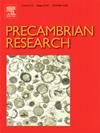阿杜杜生物群:摩洛哥阿特拉斯西部埃迪卡拉-寒武纪过渡的新窗口
IF 3.2
2区 地球科学
Q2 GEOSCIENCES, MULTIDISCIPLINARY
引用次数: 0
摘要
埃迪卡拉纪-寒武纪的过渡是生命史上最关键的时期之一,其特征是埃迪卡拉纪生态系统和动物群的衰落,以及显生型动物群的出现。对于这一生物事件,人们提出了各种各样的解释,包括埃迪卡拉纪独特的地层学窗口的关闭,一次突然的灭绝事件,或一次进化的“生物替代”事件。在这里,我们描述了一个来自摩洛哥西部反阿特拉斯的化石地点,该地点保存了后生动物痕迹化石和软体埃迪卡拉生物群,垫相关结构(MRS),以及对Adoudou组Tabia段硅屑沉积的古环境重建。我们记录了各种各样的MRS,包括与垫子相关的皱纹和垫子破坏特征,从频繁的浅淹没环境到永久的亚波基设置。此外,我们还报道了在砂岩层理平面上保存的新痕迹化石,包括T. bifurcus、Bergaueria、Helminthopsis和Archaeonassa。此外,我们描述了新的埃迪卡拉纪身体化石,包括宏观的,保存完好的Aspidella和Nimbia标本。沉积相及伴生微量化石分布的综合研究表明,演化创新对研究层段的微量化石分布起主要控制作用,该层段的微量化石地层分布与世界范围内的发现高度一致。软体埃迪卡拉动物群和后生动物痕迹化石的地层重叠表明,埃迪卡拉晚期存在独特的浅水生态系统,其中包含两个不同的多细胞分支。本文章由计算机程序翻译,如有差异,请以英文原文为准。
The Adoudou Biota: A new window on the Ediacaran-Cambrian transition from the western Anti-Atlas, Morocco
The Ediacaran-Cambrian transition represents one of the most pivotal periods in the history of life, characterized by the decline of the Ediacaran ecosystems and fauna, and the emergence of Phanerozoic-type fauna. Various interpretations have been proposed for this biological event, including the closing of the unique Ediacaran taphonomic window, a sudden extinction event, or an evolutionary “biotic replacement” event. Here, we describe a fossil locality from the western Anti-Atlas of Morocco that preserves metazoan trace fossils and soft-bodied Ediacara biota, mat-related structures (MRS), alongside a paleoenvironmental reconstruction of the siliciclastic deposits of the Tabia Member of the Adoudou Formation. We document various MRS, including mat-related wrinkles and mat destruction features reported from frequently shallow submerged environments and down to permanently sub-wavebase settings. Additionally, we report new trace fossils from this interval, including T. bifurcus, Bergaueria, Helminthopsis, and Archaeonassa preserved on the bedding plane of sandstone beds. Furthermore, we describe new Ediacaran body fossils comprising macroscopic, well-preserved specimens of Aspidella and Nimbia. An integrated study of sedimentary facies and the distribution of associated trace fossils indicates that evolutionary innovations exerted primary control on the distribution of trace fossils in the studied interval, where the stratigraphical distribution of trace fossils strongly aligns with that observed worldwide. The stratigraphic overlap of soft-bodied Ediacara biota and metazoan trace fossils suggests the existence of unique late Ediacaran shallow-water ecosystems housing two distinct multicellular clades.
求助全文
通过发布文献求助,成功后即可免费获取论文全文。
去求助
来源期刊

Precambrian Research
地学-地球科学综合
CiteScore
7.20
自引率
28.90%
发文量
325
审稿时长
12 months
期刊介绍:
Precambrian Research publishes studies on all aspects of the early stages of the composition, structure and evolution of the Earth and its planetary neighbours. With a focus on process-oriented and comparative studies, it covers, but is not restricted to, subjects such as:
(1) Chemical, biological, biochemical and cosmochemical evolution; the origin of life; the evolution of the oceans and atmosphere; the early fossil record; palaeobiology;
(2) Geochronology and isotope and elemental geochemistry;
(3) Precambrian mineral deposits;
(4) Geophysical aspects of the early Earth and Precambrian terrains;
(5) Nature, formation and evolution of the Precambrian lithosphere and mantle including magmatic, depositional, metamorphic and tectonic processes.
In addition, the editors particularly welcome integrated process-oriented studies that involve a combination of the above fields and comparative studies that demonstrate the effect of Precambrian evolution on Phanerozoic earth system processes.
Regional and localised studies of Precambrian phenomena are considered appropriate only when the detail and quality allow illustration of a wider process, or when significant gaps in basic knowledge of a particular area can be filled.
 求助内容:
求助内容: 应助结果提醒方式:
应助结果提醒方式:


